Livin’ the Dream: Tales from the Big Road Trip
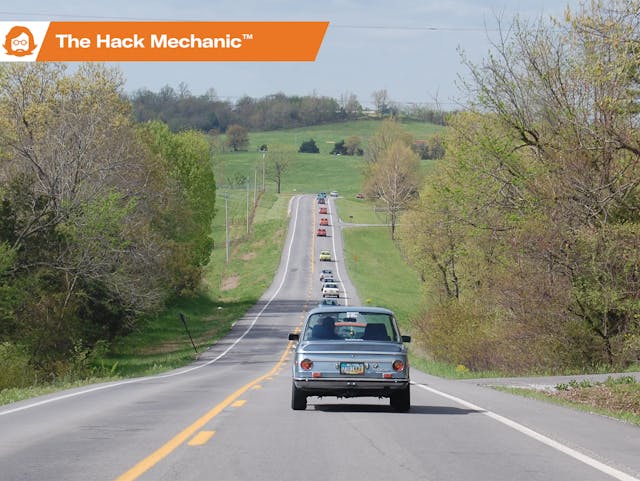
Last week, I wrote about preparing for The Big Road Trip—3000-ish miles from suburban Boston to MidAmerica 02Fest in Eureka Springs, Arkansas. I laid out my basic preparation philosophy of fixing the problems you know about, performing preventive maintenance on “The Big Seven” things likely to strand a vintage car (ignition, fuel delivery, cooling, charging, belts, clutch hydraulics, ball joints) and carrying enough spare parts and tools that you won’t feel like an idiot if something common breaks. I thought I’d let you know how it went.
The Drive
My wonderful, tolerant, passion-enabling wife doesn’t accompany me on these long-haul road trips, as her idea of hell is endless hours in a fragrant, loud old car. Really, it’s less the fragrant old car part than the endless hours part—“the forced march,” as she calls it, is not at all to her liking. Her preferred pace is the stop-and-smell-the-quilt-shops kind of road trip. I get it, but on a trip like this (1500 miles each way, broken into two 750-mile days), those miles don’t drive themselves. You have to pound them out.
Fuel, rest room, and oil-checking breaks are unlikely to be less than 15 minutes. Take four of those and it adds an hour—longer if it’s more than four (it always is) or if you need to take an actual breather or fix something. Do the math and you’ll see that, if you’re 63 years old like me who runs out of consciousness when he runs out of daylight, the goal is to be rolling into the parking lot of the hotel no later than sunset, you’re eating breakfast at dawn, hitting the road at sunup, and basically driving every waking daylight hour. Most of the time, that works for me—I love these little cars, I love road-tripping them, and I love the alone time for my brain to do the percolation thing it doesn’t get to do at home. But if I hit traffic or weather or have to stop and fix something and the drive continues after dark, it definitely ratchets back the “livin’ the dream” part.

The Caravan
As I described last week, my days of lone-wolf road trips are largely over. There are undeniable advantages in running with a pack. Even ignoring the social aspects, from a purely practical self-enlightened standpoint, there’s safety in numbers in terms of mechanical breakdowns and the ability to have someone run to the nearest Autozone for duct tape and 10-mm bolts. Maybe someone even has them in their trunk.
But pack size and makeup are crucial. Every May, I run with a regular four-person caravan to the event “The Vintage” in Asheville, North Carolina. We’re very compatible in terms of:
- Speed—We typically drive just a notch faster than traffic flow, which usually puts us in the 75–80 zone where 2002s shine.
- Passing—We keep right except to pass, only pass on the right when someone is an unforgivable left lane hog, and never weave through traffic as if we have some God-given right to carry more speed than the traffic volume will naturally allow.
- Lunch—We eat while rolling in our cars; sit-down lunches just take too long when you have pavement to pound and miles to go before you sleep.
- Hotels—We agree on something midway between a Marriot and no-tell motel).
On this trip, however, it was just me and one of these caravan members, my friend Bob Sawtelle.

There’s a tendency on the part of caravan drivers of the same cars to want to keep the pack together, but on anything other than an empty road, you just can’t keep more than a handful of consecutive cars together without interfering with traffic flow. A line of vintage cars already attracts a lot of attention, and I want it to be the good kind; I really hate the idea of my joy translating into someone else’s rage if it looks like we’re lane-hogging for photo ops. So, four or fewer is a good caravan size, and two was great. It was small enough to be as nimble as a 15-year-old gymnast on a balance beam. And, as it happened, Bob and I were both driving green BMW 2002s. His was a newer (1976) car with big bumpers and square taillights. Mine was a 1972 pre-facelift car with the classic round taillights and small bumpers. The sight of the two perky little green cars, just different enough from each other to look like Barbie and her little sister Skipper, got us so many thumbs-ups on the drive that it almost qualified as fuel.
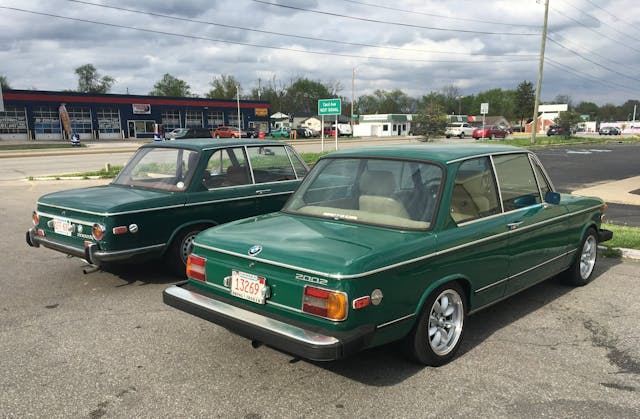
Road-wise, we took I-90 out of Boston to I-84 and stayed on it all the way into Scranton, Pennsylvania. This is a nice route that bypasses all of the old roads north of New York City and provides a lovely drive through Pennsylvania. Then it’s I-81 to I-80, at which point my memory of the last time I made this trek eight years ago proved startingly accurate—folks on I-80 know how to use the “go pedal.” There’s a time and a place for speed, and the way I look at it, if you’re not going to haul tuchus when you’re driving your treasured vintage road car, the traffic is light, the weather is flawless, Waze is clear, and the trucks are running at 80 mph, when are you going to do it? We spent hours with the 2002 engines doing what they were designed to do—zinging along at over 4000 rpm, where the molecules feel like they’re all vibrating together. We followed I-76 to I-71 and overnighted at the halfway point in Columbus, Ohio.
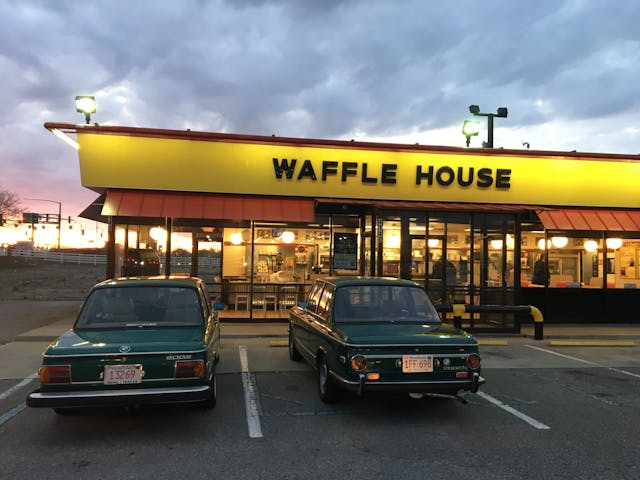
From there, the terrain flattened out as I-70 took us west into St. Louis, then I-44 canted southwest. When we got off the interstate, we boarded the roller coaster of roads bounding over the Ozarks. I’m not certain what tangle of small roads Waze put us on, but the drive was absolutely outstanding. There must be something in the water that caused three generations of Missouri and Arkansas civil engineers to build these flawlessly banked roads. As I said, I’d made this trip once before, so I knew what was coming, but my companion Bob was left practically mumbling and weak-kneed when we stopped for fuel near the hotel. Livin’ the dream. That’s how a trip like this should be—at least part of it.
At the end of the second 750-mile day of driving, there’s nothing like pulling into the hotel parking lot and having zero question that you’re in the right place.

Breakdowns
Louie, my 50-year-old 1972 BMW 2002tii, pounded out the mileage with zero drama and zero downtime. The only “Big Seven” issue was that the nuts and bolts securing the A/C compressor to its tensioner arms vibrated out, so the one time I tried to turn on the air conditioning, there was no cold air because the belt was so slack it wasn’t even engaging the pulley. Hey, at least it wasn’t the fan belt that spins the water pump and the alternator. A trip to a nearby O’Reilly’s set it right.

Three other utterly minor issues played wingman to the loose A/C compressor. It was cold the entire drive down, so I had the heat on, but the blower fan seemed anemic. When I stopped and tested it, I found it wasn’t working at all. It turned out that, last summer, I had stolen its fuse for—you guessed it—the air conditioning. I laughed out loud when I saw it missing. The engine used more oil than I would’ve preferred (like what 50-year-old engine doesn’t use more oil than you’d prefer?), a possible consequence of my having rebuilt the head—the tighter valve seals sometimes put more pressure on the old rings, piston grooves, and cylinder walls and cause oil usage to increase. And shortly before the trip, I’d aligned the front end with a trammel bar. Typically, I’ll do that and then tweak it by feel (these vintage BMWs sometimes need a touch more toe-in than spec), but I ran out of time. From the get-go, the car felt a little darty, particularly on steeply crowned center lanes. When we arrived at the hotel, I pulled the toe in a skosh. It felt much less wander-y after that.
The Event
Whether you’re into BMW 2002s or C2 Corvettes or AMC Pacers (or, for that matter, hobbies that have nothing to do with cars), a shared passion is a beautiful thing, and going to an event with people who share that passion, well, why wouldn’t you love it? All the people there are like you, at least in this one crucial way, and have also driven hundreds, maybe thousands of miles. Of course, you meet great people. Of course, you have great animated conversations. Of course, it’s like being a kid in a candy store when you walk the line of cars like yours except in different colors and ranging from bone-stock to wildly modified. And, of course, you come away with new friends. I can’t recommend it strongly enough.

This event, MidAmerica 02Fest, just celebrated its 20th year. Organizer Bo Black and his wife, Barb, hold it in the lovely little town of Eureka Springs, nestled in the northern Arkansas Ozarks just across the Missouri border. Low-key events like this, where no one is prepping their car with Q-Tips and there are no judges in white coats, are my jam. There was a group drive, tech sessions (I gave one on air conditioning), raffles, door prizes, and the coveted “Iron Butt” award given for the most miles driven to the event (I won in 2014; this year my traveling companion Bob bested me by 43 miles), but the meat of the event is really just hanging around the parking lot at the event hotel and talking 2002s with other owners.
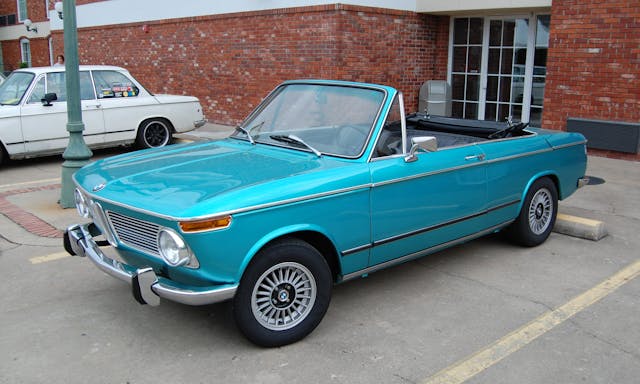
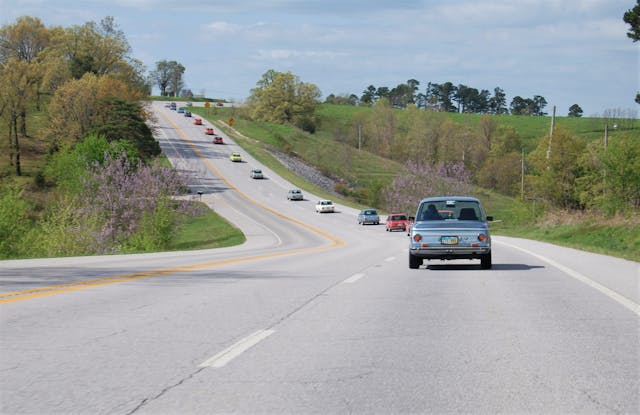
Unfortunately, when it’s over, you have to say goodbye to your old and new friends and the parking lot brimming over with seemingly endless examples of your favorite car in the world, and start the part that, well, sucks—the long drive home. Bob and I easily knocked off the leg back to Columbus, but by the second day of the two-day return trip (the fourth 750-mile day), I was toast. Back pain, neck pain, and general fatigue took their toll. When I hit drenching rain, poor visibility, and stop-and-go traffic in Connecticut, a mere two hours from home, I almost threw in the towel and got a hotel room. The only thing that enabled me to gird up my loins and finish the drive was checking the weather app on my phone and seeing that the rain was going to clear.

By the time I got home, I’d logged 3123 miles. Other than the final day, where I hit a metaphysical wall and felt fortunate that I didn’t hit a physical one, it was absolutely wonderful.
In this great big automotive enthusiast world in which we live, there are a lot of choices. For the 40 years I’ve been driving BMW 2002s, I’ve felt that the combination of their perky compact boxy exterior, quintessential 1970s minimalist German interior, road feel, handling, reliability (including the ability to sustain 80 mph without blowing head gaskets), and ease of maintenance has made them a winning package as an enthusiast car. Nothing in the round trip from Boston to Arkansas shook that one iota. Quite the contrary—it was another validation that these wonderful little cars deserve every bit of their reputation.
Life is short, my friends. You own whatever cars you do because you love them. You read these columns because you’ve boarded the escalator of connection with other people who also love cars. Trust me, you’re not going to regret going to an event where your chosen passion is shared by every single one of the attendees. It’s not going to be like the old Groucho Marx joke about not wanting to belong to a club that would want someone like you as a member. It’s going to be the opposite. It’s going to be awesome.
Just maybe find one that’s a bit closer than a 3123-mile round-trip drive.
***
Rob Siegel’s latest book, The Best of the Hack MechanicTM: 35 years of hacks, kluges, and assorted automotive mayhem, is available on Amazon. His other seven books are available here, or you can order personally inscribed copies through his website, www.robsiegel.com.

